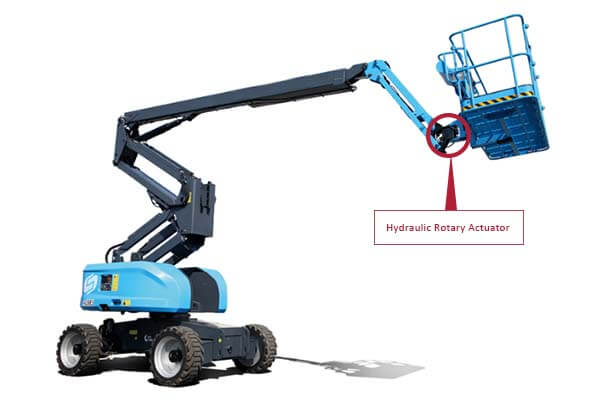For manufacturers of aerial working platforms, choosing the right hydraulic rotary actuator is crucial to ensure the equipment performs safely, reliably, and efficiently. A well-selected actuator not only enhances operational performance but also contributes to the long-term value and usability of the platform. Below are the enriched and detailed factors to consider:

1. Load Capacity and Torque Output
-
Critical Requirement: The actuator must provide sufficient torque to handle the platform’s operational loads, including the weight of personnel, tools, and materials.
-
Dynamic Forces: Consider external forces, such as wind gusts or uneven weight distribution, which can create additional torque demands.
-
Margin for Safety: It’s essential to select an actuator with a higher-than-required load and torque rating to ensure safety under unexpected stress conditions.
2. Compact Design with High Power Density
-
Space Constraints: Aerial working platforms are designed with compact frames to improve maneuverability and reach. A compact rotary actuator optimizes available space.
-
Power-to-Size Efficiency: Seek actuators that deliver maximum torque output relative to their size and weight to avoid compromising the platform’s structural design.
-
Ease of Integration: A compact design allows for easier installation and reduces the complexity of hydraulic routing.
3. Precision and Smooth Control
-
Operator Safety: Precision is critical to ensure smooth and stable platform rotation, reducing risks during delicate positioning tasks.
-
Variable Speed Control: The actuator should support variable control for slow, deliberate movements or rapid positioning as needed.
-
Feedback Mechanisms: Integration with sensors or control systems for real-time feedback enhances precision, making operation more intuitive for the user.
4. Safety Features
-
Fail-Safe Mechanisms: Built-in safety features, such as pressure relief valves and load-holding capabilities, prevent platform movement in case of hydraulic failure.
-
Emergency Locking: Locking mechanisms that engage automatically during system power loss ensure the platform remains stable, safeguarding users.
-
Compliance with Standards: Ensure the actuator complies with industry safety standards like ANSI and ISO for aerial work platforms.
5. Durability and Reliability
-
Robust Construction: Select actuators made of corrosion-resistant materials to withstand exposure to moisture, dust, and harsh weather.
-
Minimal Maintenance: Long-lasting seals, bearings, and other components reduce the frequency and cost of maintenance.
-
Cycle Life: Evaluate the actuator’s rated cycle life to ensure it can handle extended usage over time without performance degradation.
6. Energy Efficiency and Power Consumption
-
Lower Operating Costs: An energy-efficient hydraulic actuator reduces fuel or battery consumption, a critical factor for battery-powered aerial lifts.
-
Thermal Management: Choose an actuator designed to minimize heat generation, ensuring longer operation without overheating.
-
Environmental Impact: Opt for systems that use eco-friendly hydraulic fluids and have a smaller environmental footprint.
7. Customizability and Compatibility
-
Tailored Solutions: Manufacturers often need actuators tailored to specific operational requirements, such as range of motion, torque output, or environmental conditions.
-
System Integration: Ensure the actuator integrates seamlessly with the platform’s existing hydraulic system, including pumps, valves, and controls.
-
Versatile Mounting Options: Flexible mounting configurations enable easier installation and alignment within the platform’s design.
8. Environmental and Operational Suitability
-
Temperature Range: Select actuators capable of operating in extreme hot or cold conditions, depending on the platform’s deployment environment.
-
Contaminant Resistance: Actuators with enhanced sealing prevent contamination from dust, debris, and hydraulic fluid leaks, improving system longevity.
By carefully evaluating these factors, manufacturers can ensure their aerial working platforms are equipped with hydraulic rotary actuators that meet rigorous safety and performance standards while optimizing overall operational efficiency and cost-effectiveness. This thoughtful selection process ultimately contributes to a safer, more reliable, and user-friendly aerial work platform.
